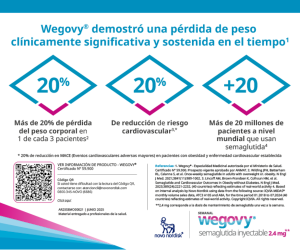Lipoprotein (a): when to order it? How to treat it?
Keywords:
lipoprotein (a), diabetesAbstract
Lipoprotein (a) [Lp(a)] consists of an LDL-c particle bound to a unique, highly glycosylated protein called apo(a), which belongs to the plasminogen gene family and exhibits unique synthetic and catabolic properties that contribute to the remarkable size heterogeneity of Lp(a).
Lp(a) is a proinflammatory, atherogenic, and prothrombotic lipoprotein that has been associated with increased cardiovascular risk in the general population, such as coronary artery disease, peripheral artery disease, heart failure, calcific aortic valve stenosis, and noncardioembolic ischemic stroke. The expression of Lp(a) levels is largely genetically determined, 70-90%, and is influenced by the expression of the LPA gene locus. Measuring Lp(a) once in a lifetime would be sufficient for most individuals, unless some secondary cause arises that modifies its levels or as a follow-up to some therapeutic measure for its lowering.
Lp(a) appears to be a residual risk factor in patients with diabetes that synergistically increases the prevalence of diabetic complications. A significant association of Lp(a) levels with a higher rate of serious coronary events has been demonstrated and a positive association of Lp(a) with an increased risk of cardiovascular disease in individuals with prediabetes has been suggested. Alterations observed in patients with type 2 diabetes mellitus (T2DM) that may explain the excessive atherogenicity of Lp(a) include hyperglycemia, insulin resistance, oxidative stress and, potentially, overproduction of β2-GPI with consequent formation of β2-GPI-Lp(a) complexes.
Furthermore, the relationship between Lp(a) and T2DM is characterized by an inverse paradoxical association, as low plasma Lp(a) concentrations have been associated with an increased risk of developing T2DM. Emerging treatments specifically targeting LPA gene expression and leading to marked reductions in Lp(a) are currently being investigated in phase III clinical trials and are expected to play a crucial role in the prevention and treatment of atherosclerosis and possibly aortic valve stenosis.
References
I. Corral C, Arrupe M, Lavalle Cobo A, Giménez S, Renna NF. Exploring the interplay between diabetes and Lp(a): implications for cardiovascular risk. Curr Diab Rep 2024; 24(7):167-172.
II. Tsamoulis D, Kosmas CE, Rallidis LS. Is inverse association between lipoprotein(a) and diabetes mellitus another paradox in cardiometabolic medicine? Expert Rev Endocrinol Metab 2024;19(1):63-70.
III. Lamina C, Ward NC. Lipoprotein (a) and diabetes mellitus. Atherosclerosis 2022; 349:63-71.
Downloads
Published
Issue
Section
License
Copyright (c) 2024 on behalf of the authors. Reproduction rights: Argentine Society of Diabetes

This work is licensed under a Creative Commons Attribution-NonCommercial-NoDerivatives 4.0 International License.
Dirección Nacional de Derecho de Autor, Exp. N° 5.333.129. Instituto Nacional de la Propiedad Industrial, Marca «Revista de la Sociedad Argentina de Diabetes - Asociación Civil» N° de concesión 2.605.405 y N° de disposición 1.404/13.
La Revista de la SAD está licenciada bajo Licencia Creative Commons Atribución – No Comercial – Sin Obra Derivada 4.0 Internacional.
Por otra parte, la Revista SAD permite que los autores mantengan los derechos de autor sin restricciones.




























